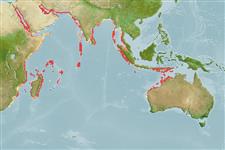Preferred temperature (Referencia
123201): 24.8 - 29.1, mean 27.4 °C (based on 464 cells).
Phylogenetic diversity index (Referencia
82804): PD
50 = 0.5005 [Uniqueness, from 0.5 = low to 2.0 = high].
Bayesian length-weight: a=0.02344 (0.01134 - 0.04848), b=2.98 (2.80 - 3.16), in cm total length, based on LWR estimates for this (Sub)family-body shape (Ref.
93245).
Nivel trófico (Referencia
69278): 2.7 ±0.3 se; based on size and trophs of closest relatives
Resiliencia (Referencia
120179): Alto, población duplicada en un tiempo mínimo inferior a 15 meses (Preliminary K or Fecundity.).
Fishing Vulnerability (Ref.
59153): Low vulnerability (10 of 100).
🛈
Nutrients (Ref.
124155): Calcium = 137 [67, 217] mg/100g; Iron = 0.815 [0.488, 1.381] mg/100g; Protein = 18.1 [16.9, 19.3] %; Omega3 = 0.111 [0.064, 0.185] g/100g; Selenium = 20 [11, 39] μg/100g; VitaminA = 102 [28, 348] μg/100g; Zinc = 2 [1, 3] mg/100g (wet weight);
